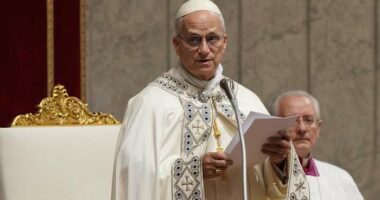Share this @internewscast.com

FRANKFURT – It appears that the European Central Bank is likely to refrain from enacting another interest rate reduction this Thursday as they await clarity on the economic impact stemming from heightened U.S. tariffs.
The ECB has already implemented eight rate cuts since June of the previous year. ECB President Christine Lagarde noted after the most recent policy meeting on June 5 that the central bank is nearing the closure of its current monetary policy phase. The monetary authority, which oversees the 20 nations using the euro, has been decreasing rates to bolster growth following previous hikes in 2022 and 2023 to suppress inflation that resulted from Russia’s incursion into Ukraine and the post-pandemic economic resurgence.
With the bench mark rate now at 2%, down from a record high of 4%, analyst think there could be one more rate cut coming, but only in September.
According to analysts, the reason behind this decision is the uncertainty surrounding the negotiations between the EU’s executive commission and the Trump administration. Initially, Trump imposed a 20% tariff on EU goods, then threatened a 50% increase, criticizing the talks’ progress, and eventually issued a warning of a possible 30% tariff. EU officials had hoped to secure at least the standard 10% rate applicable to most trade partners, with analysts suggesting that the final tariff might be less severe than Trump’s threats suggest. Although an August 1 deadline looms, previous deadlines have been extended as discussions continue.
The decision to hold rates unchanged will be “uncontroversial” among members of the bank’s rate-setting council, said analysts at UniCredit’s Investment Institute.
“In light of recent events, the risk of an adverse tariff scenario has increased since the June ECB meeting. The 30% tariff on EU goods threatened by the US is much higher than generally expected,” the UniCredit analysts wrote. “However, the response of financial markets to US President Donald Trump’s letter to the EU has been muted, and this seems to reflect expectations that the landing point for tariffs on EU goods will be materially below 30%.
With signs of economic activity holding up reasonably well, “the ECB can afford to wait and see what the outcome of trade negotiations will be.”
The ECB’s rate cuts have helped support economic activity by lowering the cost of credit for consumers and businesses to purchase goods. Higher rates have the opposite effect and are used to cool of inflation by reducing demand for goods.
Growth in the eurozone was relatively strong at 0.6% in the first quarter – though that was partly due to rushed shipments of goods trying to beat the tariffs. Inflation has fallen from double digits in late 2022 to 2% in June, in line with the ECB’s target. A stronger euro, which lowers the price of imports, and softer global prices for oil have helped keep inflation moderate.
The stronger euro, up 13% this year at $1.17, has attracted attention as a potential damper on growth and ECB Vice President Luis de Guindos said any rapid moves over $1.20 could be “much more complicated.” But the ECB typically does not target the exchange rate, and the euro’s rise is considered to be less the result of Europe’s strength and more the result of a weaker dollar weighed down by investor uncertainty about the future path of inflation, growth and government debt in the US.
Copyright 2025 The Associated Press. All rights reserved. This material may not be published, broadcast, rewritten or redistributed without permission.













